1
What monument is depicted in this
image?
Terms of Use: This file is licensed under the Creative Commons Attribution-Share Alike 3.0 Unported license. This image is attributed to Wikipedia user .
Terms of Use: This file is licensed under the Creative Commons Attribution-Share Alike 3.0 Unported license. This image is attributed to Wikipedia user .
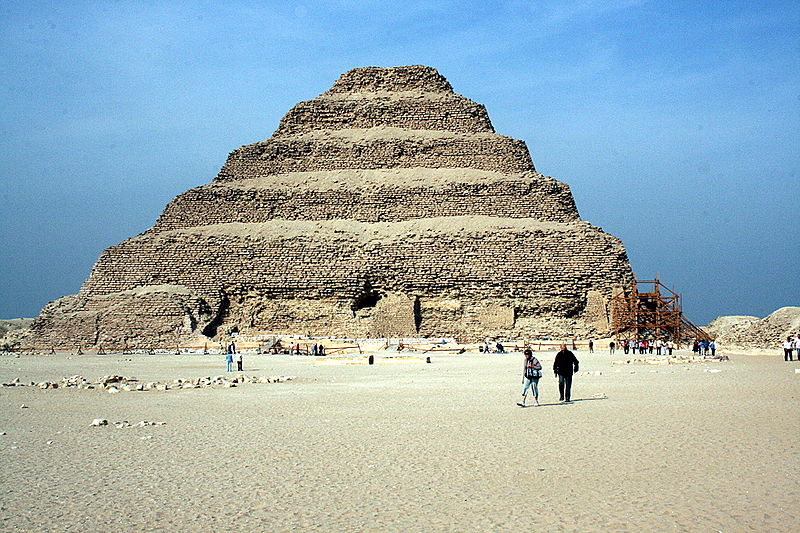
Choose one answer.
|
A.
The Step Pyramid of Djoser
|
||
|
B.
The Great Pyramid |
||
|
C.
The Meidum Pyramid |
||
|
D.
The Mortuary Temple of
Mentuhotep II |
||
|
E.
The Mortuary Temple of
Hatshepsut |
Question 2
Egyptian gods are usually not depicted as
which of the following?
Choose one answer.
|
A.
As human beings |
||
|
B.
With the head of an animal and
the body of a human
|
||
|
C.
As animals |
||
|
D.
As natural phenonmenon, such as
the sun or moon |
||
|
E.
All of the above |
Question 3
Which of the following is a traditional
symbol of ancient Egyptian royalty?
Choose one answer.
|
A.
The royal kilt with ornamental
bull's tail |
||
|
B.
A rectangular false beard
|
||
|
C.
The crook and flail
|
||
|
D.
The double crown with the
sacred uraeus |
||
|
E.
All of the above |
Question 4
What are the basic structural elements of
Egyptian art?
Choose one answer.
|
A.
The cube and the horizontal and
vertical axes |
||
|
B.
The circle and the oval
|
||
|
C.
Square forms with emphasis
placed on the vertical axis
|
||
|
D.
The pyramid |
||
|
E.
None of the above |
Question 5
Which of the following statements about
Egyptian hieroglyphs is false?
Choose one answer.
|
A.
Some hieroglyphs represent
actual objects. |
||
|
B.
No hieroglpyhs represent
individual sounds. |
||
|
C.
As much care was taken in
drawing hierogplyphs as in
creating images in art.
|
||
|
D.
Writing and art are inseperable
in Ancient Egypt. |
||
|
E.
Hieroglyphs can be written from
left to right or from right to
left. |
Question 6
Which king is depicted on this image?
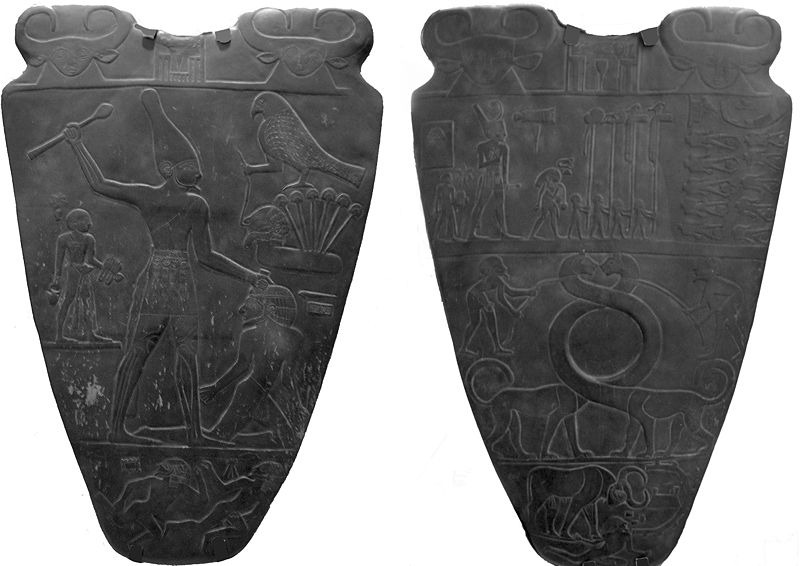
Choose one answer.
|
A.
Mentuhotep II |
||
|
B.
Narmer |
||
|
C.
Khufu |
||
|
D.
Ramses II |
||
|
E.
Khafre |
Question 7
Which of the following statements about the
Narmer Palette is false?
Choose one answer.
|
A.
At its top, the name of the
king is inscribed between two
bovine heads. |
||
|
B.
It depicts the king's victory
over his enemies. |
||
|
C.
It shows the king's enemies in
a marshland. |
||
|
D.
It was found at Thebes.
|
||
|
E.
It is made of grey schist.
|
Question 8
Which
pharaoh built this monument, known as the
Great Sphinx of Giza?

Choose one answer.
|
A.
Khafre |
||
|
B.
Khufu |
||
|
C.
Mentuhotep II |
||
|
D.
Ramses II |
||
|
E.
Seti I |
Question 9
Which of the following is true about the
Great Pyramid?
Choose one answer.
|
a.
It was orginally covered with
graite stones. |
||
|
b.
It was built by Khafre.
|
||
|
c.
It can not be entered.
|
||
|
d.
It was part of a large set of
monuments and rituals to help
the pharaoh ascend to the gods
in the heavens. |
||
|
e.
The Great Sphinx was built by
the same ruler who commissioned
it. |
Question 10
In the development of Egyptian pyramids,
which of the following came first?
Choose one answer.
|
A.
The Great Pyramid |
||
|
B.
The Meidum Pyramid |
||
|
C.
Mastabs |
||
|
D.
The Step Pyramid of Djoser
|
||
|
E.
The Bent Pyramid of Dashur
|
Question 11
Many high-ranking Old Kingdom officials
were buried at which of the following
sites?
Choose one answer.
|
A.
Saqqara |
||
|
B.
Beni-Hassan |
||
|
C.
Deir el-Bahri |
||
|
D.
Abu Simbel |
||
|
E.
Dashur |
Question 12
Which Eleventh Dynasty ruler built a
terraced tomb at Deir el-Bahri?
Choose one answer.
|
A.
Mentuhotep II |
||
|
B.
Amenemhat I |
||
|
C.
Seti I |
||
|
D.
Pepi II |
||
|
E.
Ramses II |
Question 13
During the Twelfth Dynasty the capital of
Egypt was moved to what site?
Choose one answer.
|
A.
Thebes |
||
|
B.
Hierakonopolis |
||
|
C.
Alexandria |
||
|
D.
Abu Simbel |
||
|
E.
El-Lisht |
Question 14
Which of the following is the name of the
Middle Kingdom site where provincial
governors were buried?
Choose one answer.
|
A.
Beni Hasan |
||
|
B.
El-Lisht |
||
|
C.
Deir el-Medina |
||
|
D.
Amarna |
||
|
E.
Giza |
Question 15
Which of the following statements about New
Kingdom temples is true?
Choose one answer.
|
A.
Only cult temples were built
during the New Kingdom.
|
||
|
B.
Few texts survive that describe
the construction, circumstance,
and function of New Kingdom
temples. |
||
|
C.
The standard temple followed a
tripartite plan, cons isting of
an outer court, a hypostyle (or
columned) hall, and the
sanctuary itself. |
||
|
D.
Temples are never depicted in
New Kingdom art. |
||
|
E.
The reliefs that decorate New
Kingdom temples were not
painted. |
Question 16
This image depicts the remains of the Grand
Colonnade of Amenhotep III at which
Egyptian Temple?
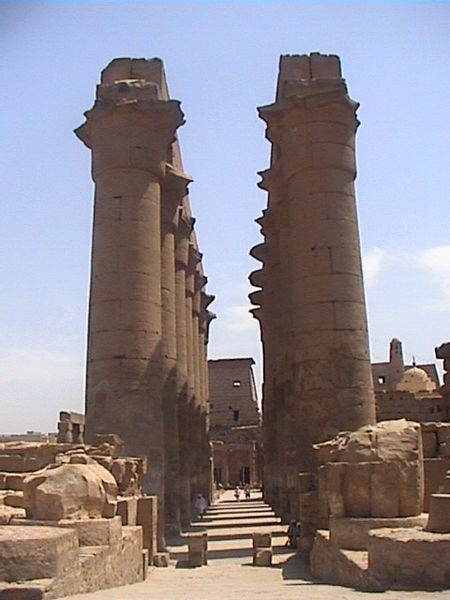
Choose one answer.
|
A.
Luxor |
||
|
B.
Abu Simbel |
||
|
C.
Karnak |
||
|
D.
The Temple Complex at Philae
|
||
|
E.
The Temple of Horus at Edfu
|
Question 17
These colossal images depict which ruler
who built the Peristyle Hall at Luxor
Temple?
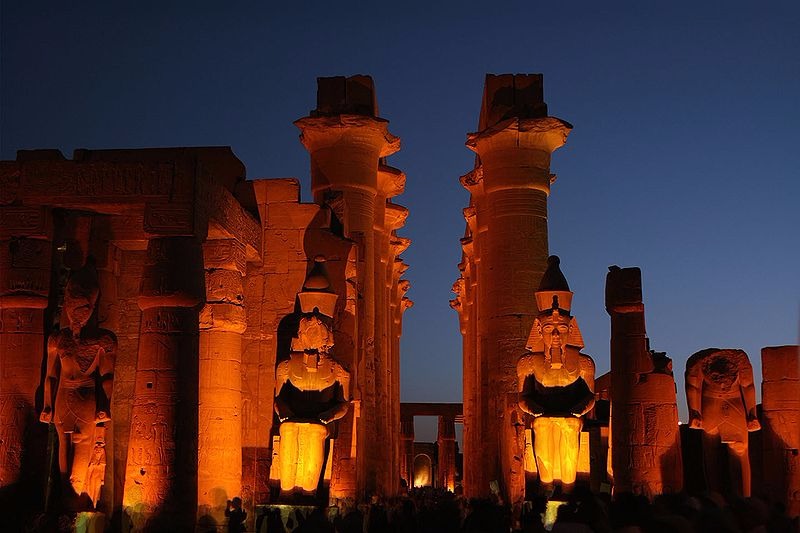
Choose one answer.
|
A.
Ramses II |
||
|
B.
Seti I |
||
|
C.
Amenhotep III |
||
|
D.
Amenhotep IV |
||
|
E.
Mentuhotep II |
Question 18
This image shows the remains of the columns
of the Hypostyle Hall of the Precinct of
Amun-Re in which temple?

Choose one answer.
|
A.
Karnak |
||
|
B.
Luxor |
||
|
C.
The Mortuarty Temple ot Seti I
|
||
|
D.
The Mortuary Temple of
Hatshepsut |
||
|
E.
Abu Simbel |
Question 19
This image depicts which pharaoh's mortuary
temple?
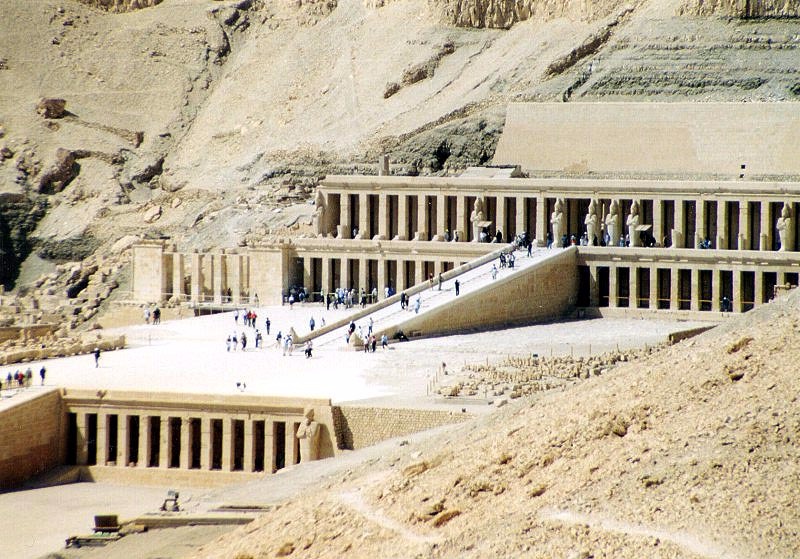
Choose one answer.
|
A.
Hatshepsut |
||
|
B.
Seti I |
||
|
C.
Akhenaten |
||
|
D.
Ramses II |
||
|
E.
Khufu |
Question 20
Which of the following statements about
Hatshepsut's Mortuary Temple is false?
Choose one answer.
|
A.
It is a multi-terraced temple.
|
||
|
B.
It was designed by the
architect Senemut. |
||
|
C.
Its terraced form was
unprecedented. |
||
|
D.
It was built into the cliffs at
Deir el-Bahri. |
||
|
E.
It contains a chapel devoted to
the goddess Hathor.
|
Question 21
Which of the following is depicted in
Hatshepsut's mortuary temple?
Choose one answer.
|
A.
The divine birth of Hatshepsut
|
||
|
B.
Hatshepsut's co-regent,
Thutmose III |
||
|
C.
An expedition to Punt
|
||
|
D.
Festival scenes |
||
|
E.
All of the above |
Question 22
This image of Seti I is from his mortuary
temple located at what site?
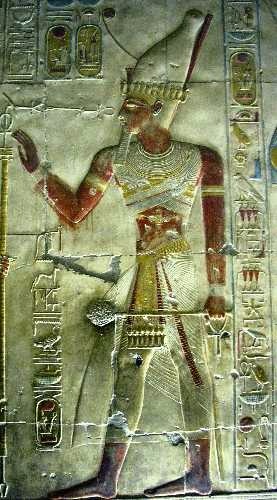
Choose one answer.
|
A.
Abydos |
||
|
B.
Deir el-Bahri |
||
|
C.
Giza |
||
|
D.
Beni Hasen |
||
|
E.
Deir el-Medina |
Question 23
Where were New Kingdom pharaohs buried?
Choose one answer.
|
A.
The Valley of the Kings
|
||
|
B.
In tombs near their mortuary
temples |
||
|
C.
Beni Hasen |
||
|
D.
In pyramids at Giza and other
sites |
||
|
E.
Saqarra |
Question 24
This depiction of Tutankhamen is heavily
influenced by depictions of the pharaoh
during which time period?
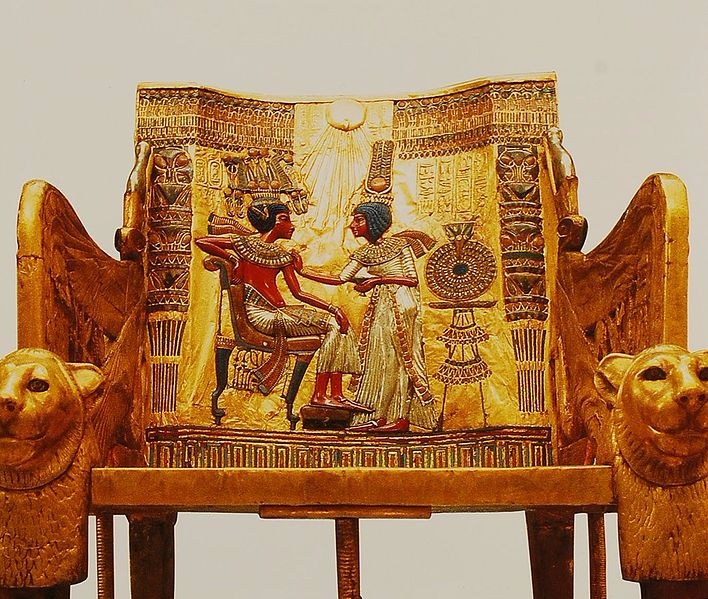
Choose one answer.
|
A.
Amarna |
||
|
B.
Old Kingdom |
||
|
C.
Middle Kingdom |
||
|
D.
First Intermediate Period
|
||
|
E.
None of the above |
Question 25
What is the name of the village where the
workers on the tombs in the Valley of the
Kings lived and were buried?
Choose one answer.
|
A.
Deir el-Medina |
||
|
B.
Beni Hasen |
||
|
C.
Abydos |
||
|
D.
Deir el-Bahri |
||
|
E.
El-Lisht |
Question 26
This image depicts which Egyptian
pharaoh?
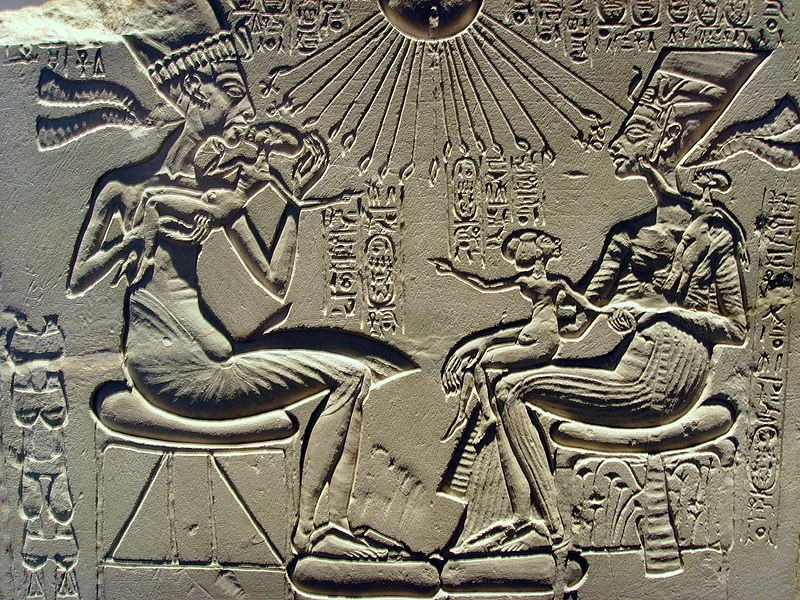
Choose one answer.
|
A.
Ramses II |
||
|
B.
Akhenaten |
||
|
C.
Senusret III |
||
|
D.
Seti I |
||
|
E.
Hatshepsut |
Question 27
Which of the following statements about
Amarna Period art is false?
Choose one answer.
|
A.
It was focused on the sun disc
Aten. |
||
|
B.
At this time, the pharaoh was
frequently depicted with his
wife and children. |
||
|
C.
Humans are usually depicted
with swelled bellies and hips,
as well as thin shoulders and
arms. |
||
|
D.
The pharaoh is frequently
depicted with the godess Maat.
|
||
|
E.
Official inscriptions reflected
everyday spoken language.
|
Question 28
Which of the following statements about
Third Intermediate Period Egyptian art and
architecture is false?
Choose one answer.
|
A.
The Third Intermediate Period
was a time when many great
temples were constructed.
|
||
|
B.
Temple networks were the center
of artistic production.
|
||
|
C.
Temple precincts were favored
burial sites. |
||
|
D.
The king was often emphasized
in art as the child/son of a
divine pair. |
Question 29
These colossal images of Ramses II are part
of which Egyptian temple?
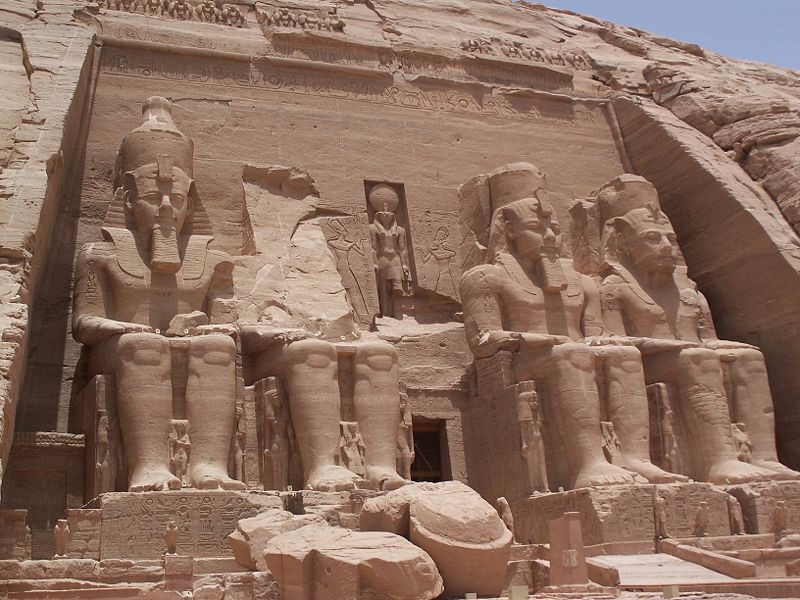
Choose one answer.
|
A.
Karnak |
||
|
B.
Luxor |
||
|
C.
Osireion |
||
|
D.
Abu Simbel |
||
|
E.
The Mortuary Temple of Seti I
|
Question 30
This sphinx of King Taharqa is from which
Egyptian dynasty?
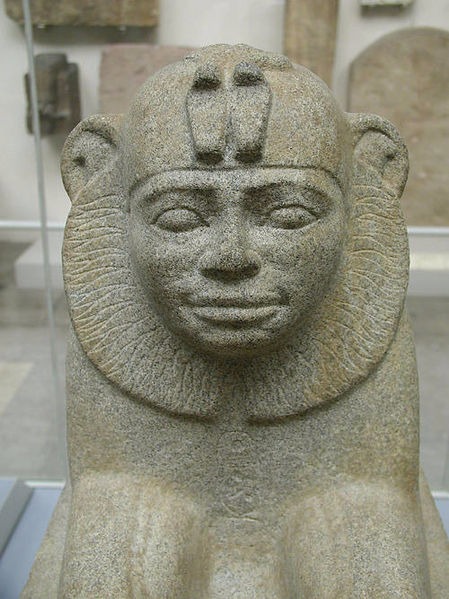
Choose one answer.
|
A.
Thirtieth Dynasty |
||
|
B.
Eleventh Dynasty |
||
|
C.
Eighteenth Dynasty |
||
|
D.
Nineteenth Dynasty |
||
|
E.
Twenty-fifth dynasty
|
Question 31
Which ruler of the Kushite or Nubian
dynasty introduced Egyptian elements into
the burial practices of Kushite/Nubian
royalty?
Choose one answer.
|
A.
Piye |
||
|
B.
Tantamani |
||
|
C.
Shabako |
||
|
D.
Taharqa |
||
|
E.
None of the above |
Question 32
Which of the following statements about
Ptolemaic art and culture is false?
Choose one answer.
|
A.
During this period, Egyptian
art was infused with
Hellenisitc elements.
|
||
|
B.
Many temples were built during
this period. |
||
|
C.
The Ptolemys did not promote
Egyptian art and culture.
|
||
|
D.
The Ptolemy were worshipped as
gods while they were living.
|
||
|
E.
All of the above |
Question 33
This ring depicts an Egyptian pharaoh from
which period?
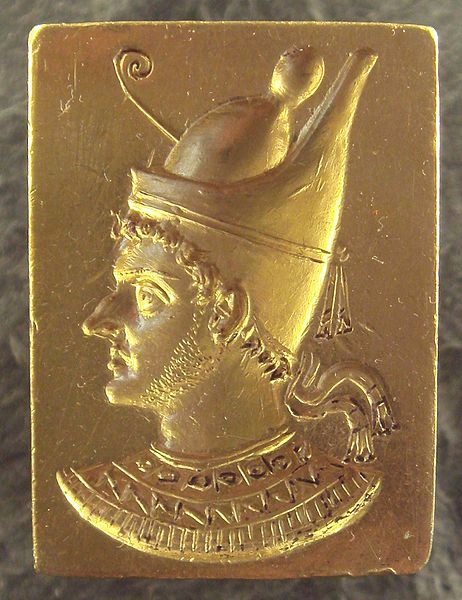
Choose one answer.
|
A.
The New Kingdom |
||
|
B.
The Ptolemaic Period
|
||
|
C.
Third Intermediate Period
|
||
|
D.
Second Intermediate Period
|
||
|
E.
Late Period |
Question 34
What type of portrait was painted on a
wooden board and attached to a mummy?
Choose one answer.
|
A.
Shabti portrait |
||
|
B.
Oinochoai portrait |
||
|
C.
Fayum portrait |
||
|
D.
Mummy masks |
||
|
E.
None of the above |
Question 35
This type of portrait was made during what
period in ancient Egypt?
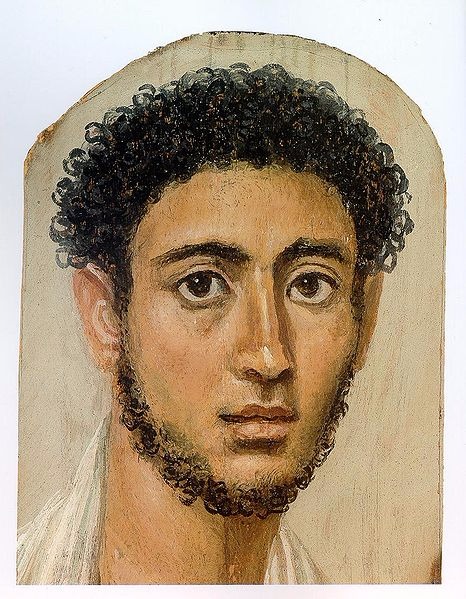
Choose one answer.
|
A.
New Kingdom |
||
|
B.
Third Intermediate Period
|
||
|
C.
Late Period |
||
|
D.
Ptolemaic Period |
||
|
E.
Roman Period |
Question 36
This image of the Temple of Hathor is from
which Egyptian site?
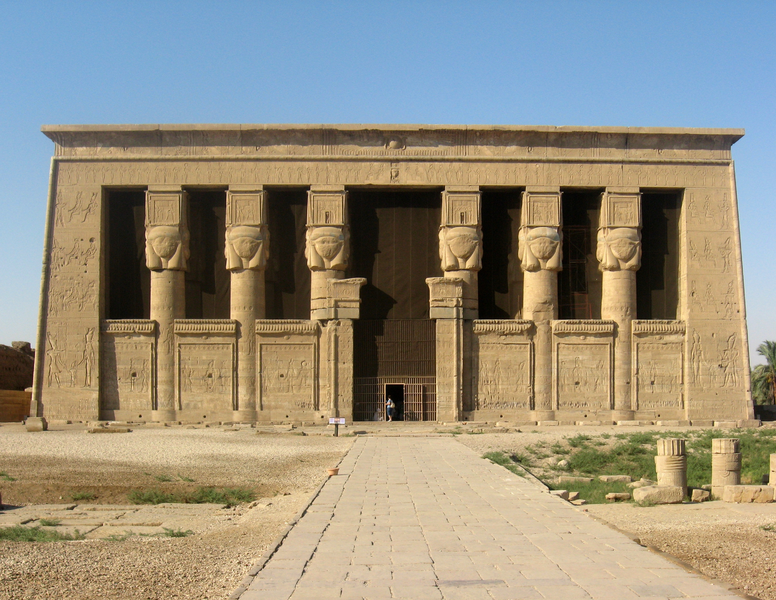
Choose one answer.
|
A.
Dendera |
||
|
B.
Abydos |
||
|
C.
Deir el-Bahri |
||
|
D.
Abu Simbel |
||
|
E.
Thebes |
Question 37
This image depicts the entrance to what
Ptolemaic Egyptian temple?
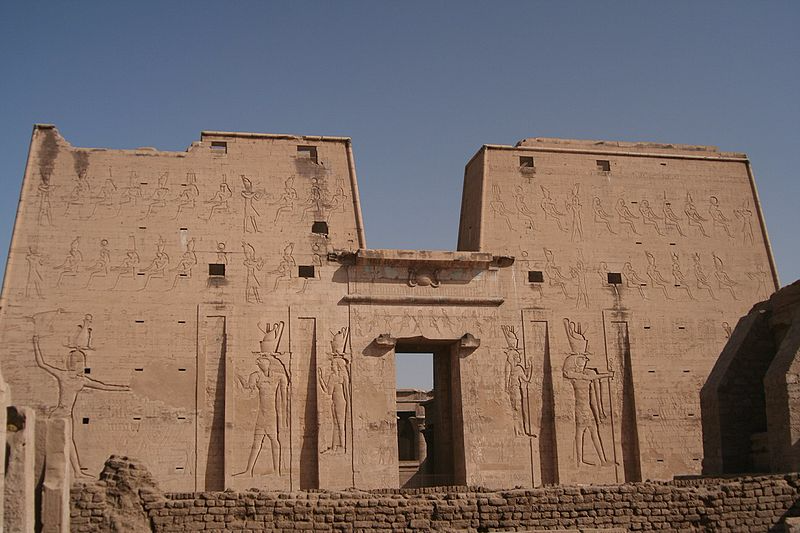
Choose one answer.
|
A.
Abu Simbel |
||
|
B.
The Temple of Philae
|
||
|
C.
Luxor Temple |
||
|
D.
The Temple of Horus at Edfu
|
||
|
E.
None of the above |
Question 38
Which of the following gods was the focus
of the Temple Complex at Philae?
Choose one answer.
|
A.
Amun |
||
|
B.
Maat |
||
|
C.
Isis |
||
|
D.
Horus |
||
|
E.
Osiris |
Question 39
Megaliths with reliefs have been found at
what Ancient Near Eastern Neolithic site?
Choose one answer.
|
A.
Göbekli Tepe |
||
|
B.
Jericho |
||
|
C.
'Ain Ghazal |
||
|
D.
Uruk |
||
|
E.
Nevali Çori |
Question 40
This image is of a figurine from which Near
Eastern prehistoric site?
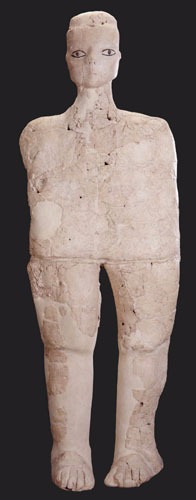
Choose one answer.
|
A.
Göbekli Tepe |
||
|
B.
'Ain Ghazal |
||
|
C.
Jericho |
||
|
D.
Uruk |
||
|
E.
Nevali Çori |
Question 41
Which of the following is the site of a
large Neolithic village in Turkey that
flourished from about 9400-7700 years ago?
Choose one answer.
|
A.
Jericho |
||
|
B.
Nevali Çori |
||
|
C.
'Ain Ghazal |
||
|
D.
Çatalhöyük |
||
|
E.
Uruk |
Question 42
Choose one answer.
|
A.
Ain Ghazal |
||
|
B.
Jericho |
||
|
C.
Uruk |
||
|
D.
Çatalhöyük |
||
|
E.
Nevali Çori |
Question 43
This image is an example of what kind of
Ancient Near Eastern object?
Terms of Use: This image is in the public domain.
Terms of Use: This image is in the public domain.
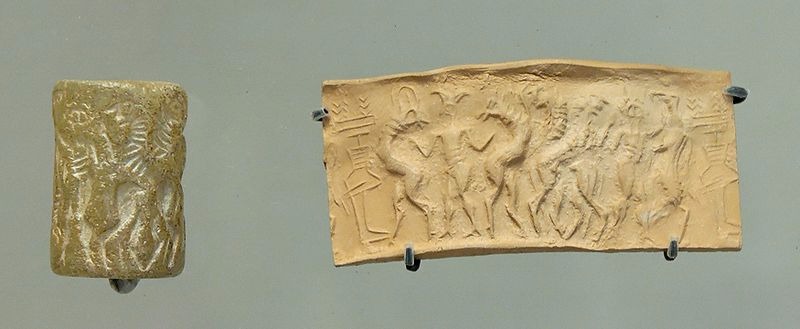
Choose one answer.
|
A.
A cylinder seal |
||
|
B.
A portion of a cone mosaic
|
||
|
C.
A stamp seal amulet
|
||
|
D.
A papyrus |
||
|
E.
None of the above |
Question 44
Which of the following, although never a
capital, was an important sacred center
that often played an important role in
Mesopotamian politics?
Choose one answer.
|
A.
Pasargadae |
||
|
B.
Babylon |
||
|
C.
Nippur |
||
|
D.
Nimrud |
||
|
E.
Ninevah |
Question 45
Nippur was the sacred city of what
Mesopotamian god?
Choose one answer.
|
A.
Ashur |
||
|
B.
Enlil |
||
|
C.
Dumuzi |
||
|
D.
Gula |
||
|
E.
Ianna |
Question 46
This object was found at what Ancient Near
Eastern site?
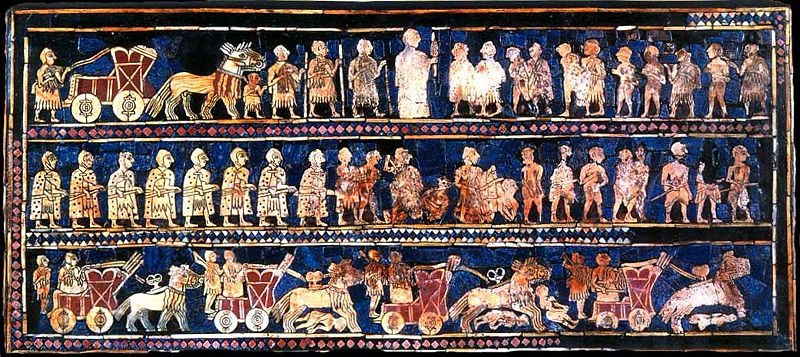
Choose one answer.
|
A.
Nippur |
||
|
B.
Ziggurat of Ur |
||
|
C.
The Royal Graves of Ur
|
||
|
D.
Uruk |
||
|
E.
Tell Asmar |
Question 47
Which of the following statements about
Early Dynastic Mesopotamian sculpture is
false?
Choose one answer.
|
A.
The majority of these statues
were votive figures.
|
||
|
B.
They only depict female
worhsippers. |
||
|
C.
They are made of gypsum or
limestone. |
||
|
D.
Many have inlaid eyes and
painted hair. |
||
|
E.
Facial characteristics show
little variation between
statues. |
Question 48
This statue, discovered at the Temple of
Ishtar at Mari, is from what period?
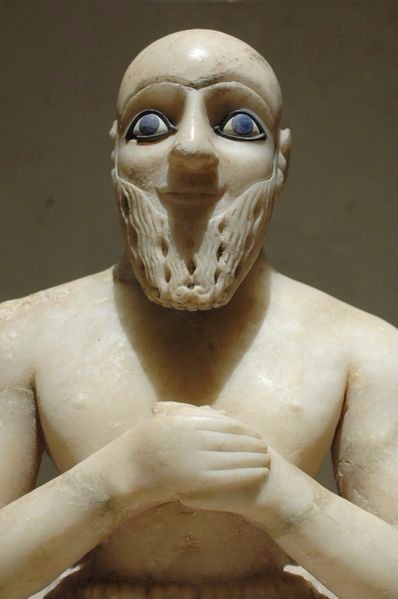
Choose one answer.
|
A.
Old Babylonian Period
|
||
|
B.
Early Dynastic Period
|
||
|
C.
Neo-Sumerian Period
|
||
|
D.
Neo-Assyrian Period
|
||
|
E.
Neolithic Period |
Question 49
Which of the following statements about
ziggurats is true?
Choose one answer.
|
A.
They can be entered through a
door at their base.
|
||
|
B.
They are mud-brick stepped
towers with temples at their
top. |
||
|
C.
They were only built during the
Early Dynastic Period.
|
||
|
D.
They were royal tombs.
|
||
|
E.
None of the above |
Question 50
This image is an example of what type of
Ancient Near Eastern structure?
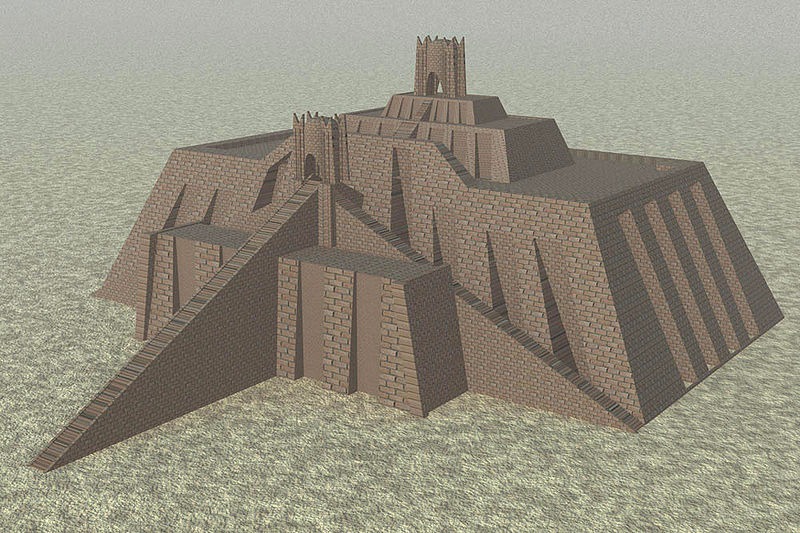
Choose one answer.
|
A.
A step pyramid |
||
|
B.
A "true" pyramid |
||
|
C.
A ziggurat |
||
|
D.
A royal palace |
||
|
E.
A royal tomb with a mortuary
temple at its top |
Question 51
This royal portrait head is from what
period?

Choose one answer.
|
A.
Early Dynastic Period
|
||
|
B.
Akkadian Period |
||
|
C.
Neo-Sumerian Period
|
||
|
D.
Old Babylonian Period
|
||
|
E.
Neo-Assyrian Period
|
Question 52
This image is a detail of what larger
Ancient Near Eastern work?
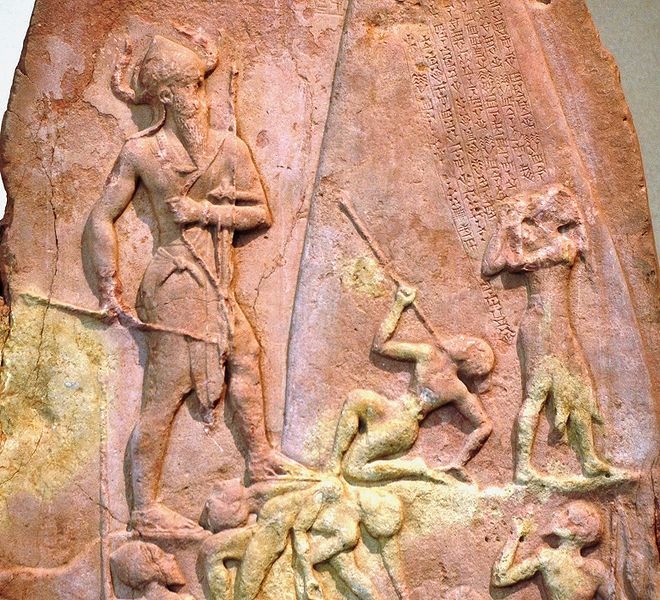
Choose one answer.
|
A.
Stele with the Law Code of
Hammurabi |
||
|
B.
The Royal Standard of Ur
|
||
|
C.
Victory Stele of Naram-Sin
|
||
|
D.
A modern impression of a
cylinder seal |
||
|
E.
None of the above |
Question 53
In which of the following ways is
Naram-Sin's status and power shown in the
Victory Stele of Naram-Sin?
Choose one answer.
|
A.
His horned helmet |
||
|
B.
The many weapons he carries
|
||
|
C.
His size |
||
|
D.
His physcial closeness to the
gods |
||
|
E.
All of the above |
Question 54
This is a statue of what Ancient Near
Eastern ruler?
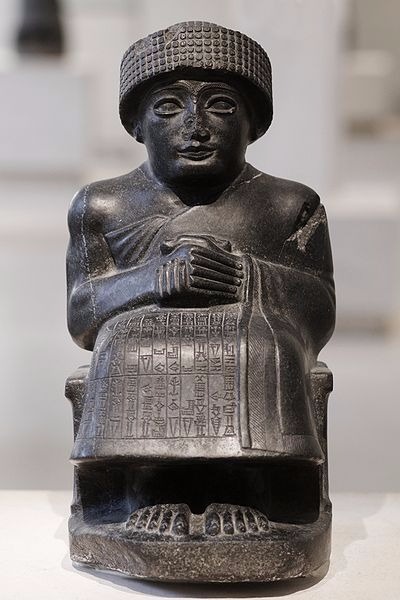
Choose one answer.
|
A.
Gudea |
||
|
B.
Sargon II |
||
|
C.
Hammurabi |
||
|
D.
Ashurnasirpal II |
||
|
E.
Ur-Nammu |
Question 55
This image depicts a detail of what Ancient
Near Eastern object?

Choose one answer.
|
A.
The Victory Stele of Naram-Sin
|
||
|
B.
A relief from the Northwest
Palace of Ashurnasirpal II
|
||
|
C.
The Standard of Ur |
||
|
D.
Stele with the Law Code of
Hammurabi |
||
|
E.
None of the above |
Question 56
The following is an example of zoomorphic
art created by what group of people?

Choose one answer.
|
A.
Babylonians |
||
|
B.
Sumerians |
||
|
C.
Assyrians |
||
|
D.
Persians |
||
|
E.
Hittites |
Question 57
Which of the following was the site of an
ancient Hittite capital?
Choose one answer.
|
A.
Lagesh |
||
|
B.
Yazilikaya |
||
|
C.
Hattusha |
||
|
D.
Uruk |
||
|
E.
Nippur |
Question 58
These carvings were found at what Hittite
site?
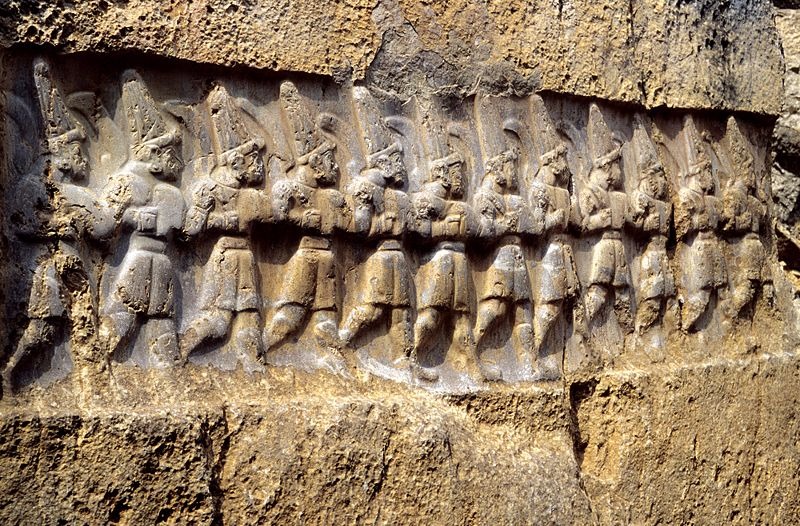
Choose one answer.
|
A.
Hattusha |
||
|
B.
Çatalhöyük |
||
|
C.
Uruk |
||
|
D.
Yazilikaya |
||
|
E.
Tell Asmar |
Question 59
King Ashurnasirpal II's Northwest Palace
was built on what modern site?
Choose one answer.
|
A.
Nimrud |
||
|
B.
Tell Asmar |
||
|
C.
Ninevah |
||
|
D.
Susa |
||
|
E.
Pasargadae |
Question 60
This is a representation of what type of
Ancient Near Eastern mythological
creature?
Terms of Use: This file is licensed under the Creative CommonsAttribution-Share Alike 3.0 Unported license. This image is attributed to Wikimedia user .
Terms of Use: This file is licensed under the Creative CommonsAttribution-Share Alike 3.0 Unported license. This image is attributed to Wikimedia user .
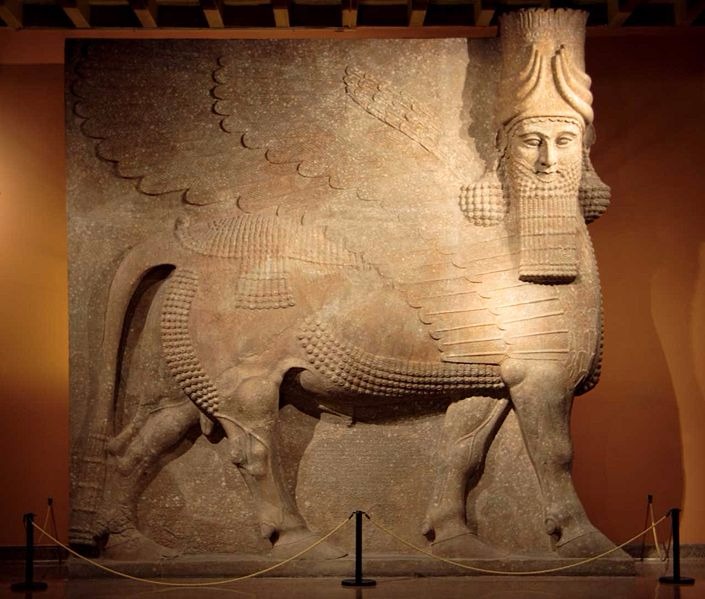
Choose one answer.
|
A.
Labbu |
||
|
B.
Sirrush |
||
|
C.
Gidim |
||
|
D.
Lamassu |
||
|
E.
Allu |
Question 61
Which of the following statements about the
Northwest Palace of Ashurnasirpal II is
false?
Choose one answer.
|
A.
The palace was organized around
three large courtyards.
|
||
|
B.
The king does not appear in any
of the reliefs that decorate
the palace. |
||
|
C.
It was built in the ancient
city of Kahlu. |
||
|
D.
State apartments and the major
throne room were situated
around the first courtyard.
|
||
|
E.
The living quarters were
located in the innermost
courtyard. |
Question 62
This relief, excavated from Khorsabad,
depicts which Neo-Assyrian ruler with a
dignitary?
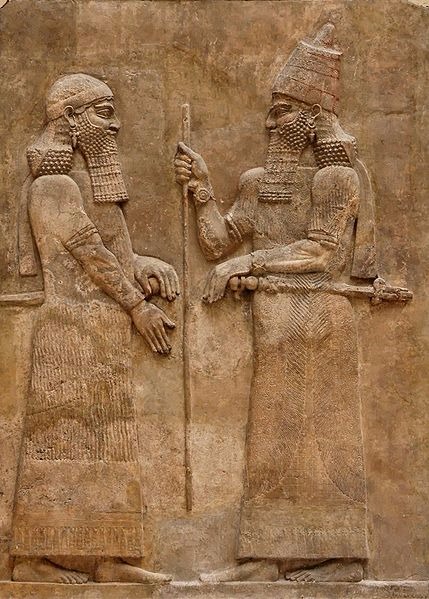
Choose one answer.
|
A.
Ashurnasirpal II |
||
|
B.
Sargon II |
||
|
C.
Tiglath-Pileser III
|
||
|
D.
Sennacherib |
||
|
E.
Esarhaddon |
Question 63
Which Neo-Assyrian ruler moved the capital
to Nineveh?
Choose one answer.
|
A.
Sargon II |
||
|
B.
Sennacherib |
||
|
C.
Ashurbanipal |
||
|
D.
Ashurnasirpal II |
||
|
E.
Tiglath-Pileser III
|
Question 64
This image is a reconstruction of what
Ancient Near Eastern architectural
feature?
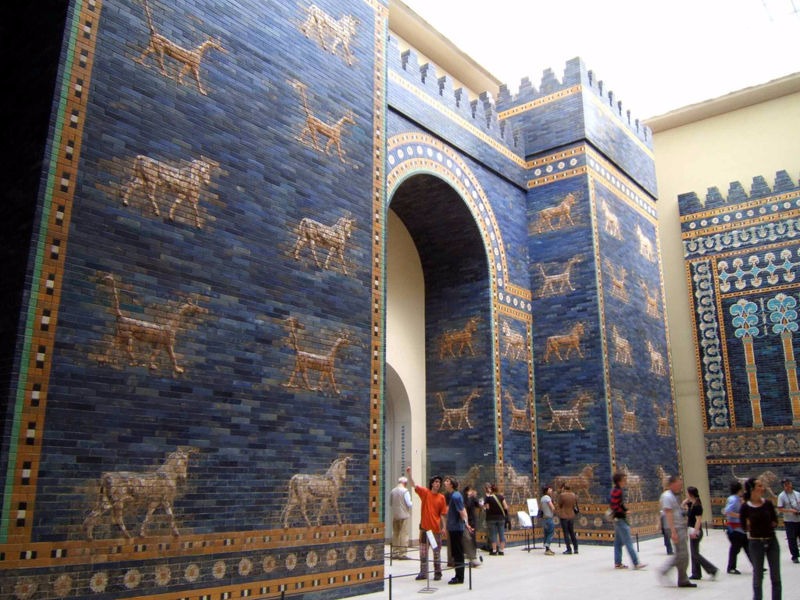
Choose one answer.
|
A.
The entrance to Sargon II's
throne room |
||
|
B.
Ziggurat of Ur |
||
|
C.
The Ishtar Gate |
||
|
D.
The hypostyle hall of
Ashurnasirpal II's palace
|
||
|
E.
Nineveh's Processional Way
|
Question 65
What do the animals that decorate the
Ishtar Gate and Nebuchadnezzar II's
Processional Way symbolize?
Choose one answer.
|
A.
The patron gods of Babylon
|
||
|
B.
The power of the king
|
||
|
C.
The king's subjects
|
||
|
D.
Nature spirits |
||
|
E.
People who the king has
conquered in battle
|
Question 66
This image depicts what Ancient Near
Eastern structure?
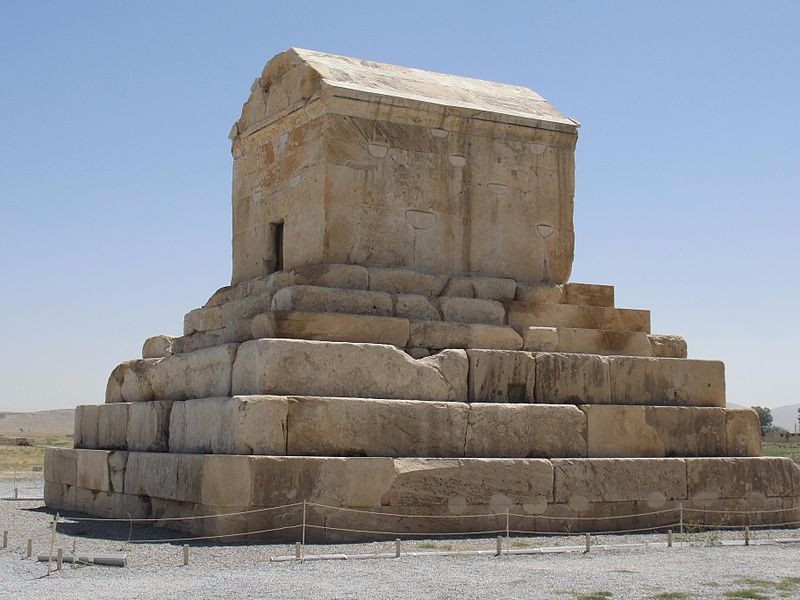
Choose one answer.
|
A.
The Tomb of Cyrus the Great
|
||
|
B.
Ziggurat of Ur |
||
|
C.
The Yazilikaya rock-cut
sanctuary |
||
|
D.
The Prison of Solomon
|
||
|
E.
Tall-i Takht |
Question 67
Which of the following cities was the
capital of Cyrus the Great?
Choose one answer.
|
A.
Susa |
||
|
B.
Persepolis |
||
|
C.
Cyropolis |
||
|
D.
Pasargadae |
||
|
E.
Estakhar |
Question 68
Darius I and Xerxes built large palaces and
other buildings at which major Persian
dynastic center?
Choose one answer.
|
A.
Pasagardae |
||
|
B.
Estakhr |
||
|
C.
Cyropolis |
||
|
D.
Persepolis |
||
|
E.
All of the above |
Question 69
This image depicts the remains of what
ancient Near Eastern capital?

Choose one answer.
|
A.
Ur |
||
|
B.
Ninevah |
||
|
C.
Hattusha |
||
|
D.
Babylon |
||
|
E.
Persepolis |
Question 70
Which of the following structures was NOT
built at Persepolis?
Choose one answer.
|
A.
The Apadana |
||
|
B.
The Palace of Darius
|
||
|
C.
The Tomb of Cyrus the Great
|
||
|
D.
The Palace of Xerxes
|
||
|
E.
The Throne Hall or Hundred
Column Hall |
Question 71
Which of the following is true about
mortuary art and architecture of the First
Intermediate Period?
Choose one answer.
|
a.
This is the time when the Great
Pyramid at Giza was
constructed. |
||
|
b.
High-ranking officials during
this period were buried in
mastabas. |
||
|
c.
During this time kings were
buried in the Valley of the
Kings. |
||
|
d.
During this period many local
artistic and architectural
styles developed. |
||
|
e.
Art and architecture from this
period does not show many
regional variations.
|
Question 72
The Narmer Palette is traditionally
connected to which historical event?
Choose one answer.
|
A.
The defeat of the Hyksos
|
||
|
B.
The unification of Upper and
Lower Egypt |
||
|
C.
Ramses II's conquest of Nubia
|
||
|
D.
Ramses II's first Syrian
campaign |
||
|
E.
None of the above |
Question 73
Which of the following is NOT a development
in Egyptian mortuary art and architecture
during the Second Intermediate Period?
Choose one answer.
|
A.
Hysksos-style burials for
high-ranking officials
|
||
|
B.
Rishi or human-shaped coffins
decorated with vulture's wings
|
||
|
C.
The construction of royal
rock-cut tombs near Thebes
|
||
|
D.
The end of the tradition of
royal burial in pyramids
|
||
|
E.
The development of regional art
styles |
Question 74
This type of coffin that is human-shaped
with vulture wings that wrap the body first
appeared during which period?

Choose one answer.
|
A.
Second Intermediate Period
|
||
|
B.
New Kingdom |
||
|
C.
Early Dynastic |
||
|
D.
Middle Kingdom |
||
|
E.
Third Intermediate Period
|
Question 75
This image shows examples of what kind of
figures that were substitutes for the
deceased?

Choose one answer.
|
A.
Rishi |
||
|
B.
Canopic jars |
||
|
C.
Shabti |
||
|
D.
Mastaba |
||
|
E.
None of the above |
Question 76
This is a diagram of what kind of structure
in which many Old Kingdom high-ranking
officials were buried?

Choose one answer.
|
A.
Pit grave |
||
|
B.
Rock-cut tomb |
||
|
C.
Mastaba |
||
|
D.
Bent pyramid |
||
|
E.
Ziggurat |
Question 77
Which of the following statements about the
tombs of high-ranking Old Kingdom officials
is false?
Choose one answer.
|
A.
They contain reliefs,
paintings, and statuary that
were often created by the same
craftsman who worked on the
tombs of the pharaohs.
|
||
|
B.
Their hieroglyphic inscriptions
record the tomb owner's titles
and rank. |
||
|
C.
Their reliefs depict the daily
activity of producing food and
other provisions needed by the
deceased's spirit. |
||
|
D.
They were not constructed near
royal tombs. |
||
|
E.
They have a rectangular
superstructure. |
Question 78
Which of the following statements about the
Tomb of Meketre is true?
Choose one answer.
|
A.
It was constructed during the
Old Kingdom. |
||
|
B.
It is famous for its many
models of boats and scenes of
daily life. |
||
|
C.
It was built in Saqarra.
|
||
|
D.
It has a rectangular
superstructure. |
||
|
E.
None of the above |
Question 79
This image depicts which Egyptian god
mummifying the body of the deceased?
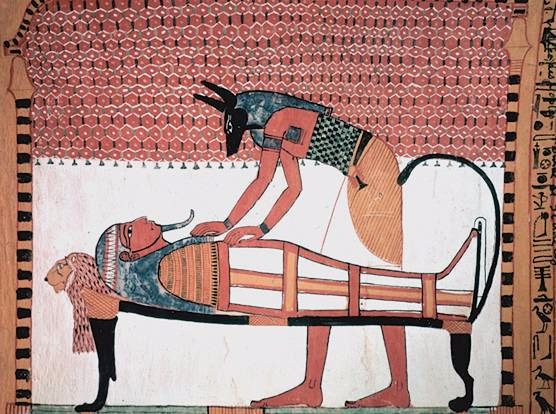
Choose one answer.
|
A.
Anubis |
||
|
B.
Thoth |
||
|
C.
Amun |
||
|
D.
Mut |
||
|
E.
Osiris |
Question 80
The pharaoh in this relief holds what
Egyptian hieroglyph that is the symbol for
life?
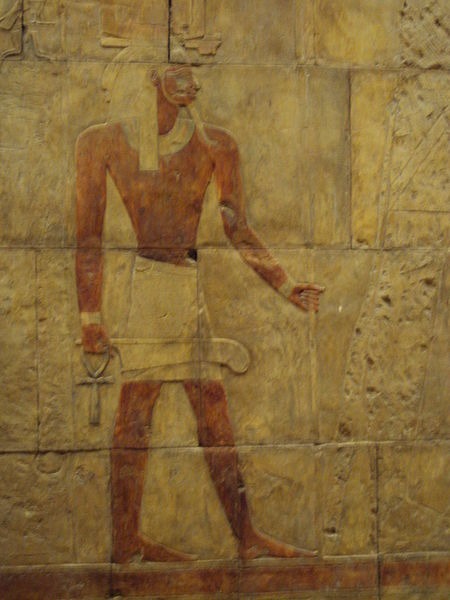
Choose one answer.
|
A.
Djet |
||
|
B.
Kheper |
||
|
C.
Shen |
||
|
D.
Ankh |
||
|
E.
Djed |
Question 81
This statue of Hatshepsut from her mortuary
temple depicts the pharaoh as what Egyptian
god?

Choose one answer.
|
A.
Amun |
||
|
B.
Mut |
||
|
C.
Osiris |
||
|
D.
Anubis |
||
|
E.
Horus |
Question 82
Where were obelisks in New Kingdom temples
typically erected?
Choose one answer.
|
A.
Flanking the entrance to the
temple |
||
|
B.
Lining the processional way
|
||
|
C.
In the Inner Sanctuary
|
||
|
D.
Inside the Outer Court
|
||
|
E.
All of the above |
Question 83
Which of the following statements about the
statues found at 'Ain Ghazal is true?
Choose one answer.
|
A.
They are dated to the Early
Dynastic Period. |
||
|
B.
They were formed by modeling
wet plaster on a reed core.
|
||
|
C.
They do not include human
figurines. |
||
|
D.
They were recovered from one of
the first "true" cities.
|
||
|
E.
Similar statues have been
recovered from nearby sites.
|
Question 84
Which of the following statements about the
site of Jericho is false?
Choose one answer.
|
A.
The remains of its earliest
structures date to the Akkadian
period. |
||
|
B.
It is one of the world's
longest inhabited sites.
|
||
|
C.
The first major settlement
there included a large tower
with an internal staircase.
|
||
|
D.
Painted skulls have been
recovered from the ancient
site. |
||
|
E.
The first settlement there
dates back to about 9000 BCE.
|
Question 85
Which of the following statements about the
site of Uruk is false?
Choose one answer.
|
A.
It included monumental
mud-brick buildings, decorated
with mosaics of painted clay
cones embedded in the walls.
|
||
|
B.
It was the largest settlement
in the world c.3200 BCE.
|
||
|
C.
Large-scale sculpture in the
round and relief carving was
created in Uruk for the first
time. |
||
|
D.
Simple pictographs drawn on
clay tablets have been
recovered from this site.
|
||
|
E.
It is the largest Neolithic
site excavated to date.
|
Question 86
What was the primary goal of much of the
art that was created in the Ancient Near
East from the Third Millennium BCE onward?
Choose one answer.
|
A.
To help the dead in the
afterlife |
||
|
B.
To obtain power over the forces
of nature |
||
|
C.
To capture the relationship
between the divine and
terrestrial realms |
||
|
D.
To be used as everyday
utilitarian objects by the
royal household |
||
|
E.
None of the above |
Question 87
Who was the occupant of the most complete
Royal Tomb of Ur who may have been a queen
or a high priestess?
Choose one answer.
|
A.
Semiramis |
||
|
B.
Pu-abi |
||
|
C.
Ur-Nammu |
||
|
D.
Ishtar |
||
|
E.
None of the above |
Question 88
Which of the following statements about
Akkadian art is true ?
Choose one answer.
|
A.
Early Akkadian art drew on the
style and iconography of Early
Dynastic Period art.
|
||
|
B.
Very little large scale
Akkadian sculpture has
survived. |
||
|
C.
Many Akkadian seals survive and
have a rich iconography
demonstarating interactions
between the terrestrial and
divine worlds. |
||
|
D.
When fully developed, Akkadian
monumental sculpture emphasized
naturalism through subtle
modeling. |
||
|
E.
All of the above |
Question 89
Which of the following elements, standard
in later Assyrian palace architecture, is
first seen in the Northwest Palace of
Ashurnasirpal II?
Choose one answer.
|
A.
A large throne room
|
||
|
B.
Huge carved alabaster panels
decorated with reliefs that
lined the interior walls
|
||
|
C.
A plan organized around three
large halls |
||
|
D.
An underground tunnel
connecting it to a nearby
temple |
||
|
E.
The king's tomb constructed in
the interior of the palace
|
Question 90
Which of the following frequently decorate
the interior of Neo-Assyrian palaces?
Choose one answer.
|
A.
Winged beings/deities
|
||
|
B.
The king or princes hunting
lions |
||
|
C.
Lamassu |
||
|
D.
Tribute-bearers |
||
|
E.
All of the above |
Question 91
What were the images that decorate the
Ishtar Gate and the Processional Way made
of?
Choose one answer.
|
A.
Alabaster |
||
|
B.
Sandstone |
||
|
C.
Glazed ceramic tiles
|
||
|
D.
Granite |
||
|
E.
Mud-bricks with mosaics of
painted clay cones |
Question 92
Which of the following is NOT found
decorating the Ishtar Gate and the
Processional Way?
Choose one answer.
|
A.
Nebuchadnezzar II |
||
|
B.
Lions |
||
|
C.
Aurochs |
||
|
D.
Dragons |
||
|
E.
Symbols of the gods Ishtar and
Marduk |
Question 93
Which of the following are often found on
the reliefs commissioned by Darius I and
his successors at Persepolis?
Choose one answer.
|
A.
Animals that symbolize
Mesopotamian gods |
||
|
B.
The construction of the
buildings at Persepolis
|
||
|
C.
Tributatires from different
parts of the Empire processing
toward the enthroned king
|
||
|
D.
Musicians and dancers
|
||
|
E.
Scenes of daily life
|
Question 94
Achaemenid rulers built palaces at which of
the following sites?
Choose one answer.
|
A.
Babylon |
||
|
B.
Susa |
||
|
C.
Persepolis |
||
|
D.
Pasargadae |
||
|
E.
All of the above |
Question 95
This image depicts a symbol of which
Babylonian god?

Choose one answer.
|
A.
Ishtar |
||
|
B.
Marduk |
||
|
C.
Enlil |
||
|
D.
Sin |
||
|
E.
Apsu |
Question 96
This image depicts what kind of script that
was developed in Mesopotamia?

Choose one answer.
|
A.
Cuneiform |
||
|
B.
Hieratic |
||
|
C.
Hieroglyphs |
||
|
D.
Aramaic |
||
|
E.
Phoenician |
Question 97
This royal portrait head possibly depicts
what Ancient Near Eastern ruler?

Choose one answer.
|
A.
Sargon |
||
|
B.
Hammurabi |
||
|
C.
Naram-Sin |
||
|
D.
Ashurnasirpal II |
||
|
E.
Ur-Nammu |
Question 98
Silver or gold objects such as this one
were popular drinking vessels during which
period?
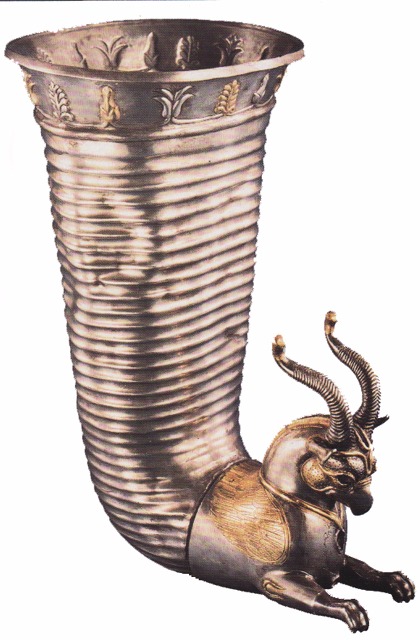
Choose one answer.
|
A.
Achaemenid Period |
||
|
B.
Akkadian Period |
||
|
C.
Neo-Assyrian Period
|
||
|
D.
Early Dynastic Period
|
||
|
E.
Neo-Sumerian Period
|
Question 99
What Neo-Assyrian ruler named the palace he
built in his new capital city, "The Palace
Without Rival"?
Choose one answer.
|
A.
Sennacherib |
||
|
B.
Ashurnasirpal II |
||
|
C.
Sargon II |
||
|
D.
Tiglath Pileser III
|
||
|
E.
Shalmeneser III |
Question 100
What Neo-Babylonian ruler built the Ishtar
Gate?
Choose one answer.
|
A.
Nebuchadnezzar II |
||
|
B.
Hammurabi |
||
|
C.
Nabopolassar |
||
|
D.
Amel-Marduk |
||
|
E.
Neriglissar |